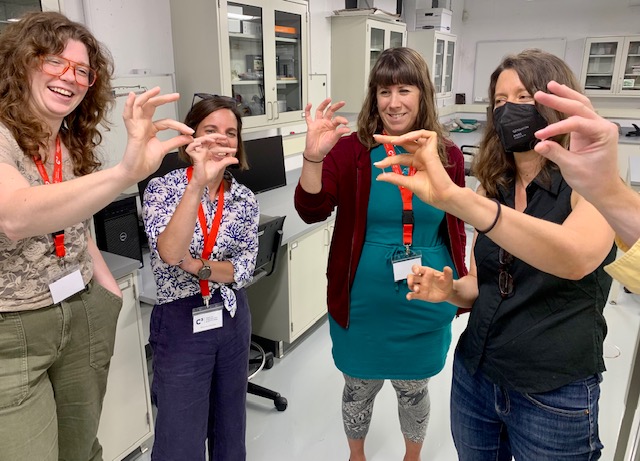C3 elevates collection specialists’ skills with top-notch teachers and a museum-rich campus
Beloit College’s Center for Collections Care (C3) awarded $350K National Endowment for the Humanities (NEH) Preservation and Access Education and Training Grant broaden the program.
For centuries, Mexican craftspeople have transformed natural fibers into intricate textile art by hand-weaving and embroidery. The crafting of deshilado or hazme si puedes stitchwork is so delicate that it challenges the creator slyly to “make me, if you can.”

“It blew my mind when I learned about the technique of making this garment,” Meister says. “Individual threads are removed to create gaps that are then re-threaded to make patterns and texture. This blouse is very high-quality work, but it needs some conservation.”
Conservation experts and novices come to Beloit College’s Center for Collections Care, nicknamed C3, to learn to care for precious artifacts, just like this Mexican blouse.

C3 participants are historical society volunteers, private collectors, and professionals from organizations across the country like the Getty Villa Museum, Detroit Institute of Arts, and Thomas Jefferson’s Monticello. The common thread is their interest in preserving artifacts and art.

Novices learn the ropes in the Fundamentals of Collections Care online class and progress to more advanced, material-specific, hands-on, and in-person conservation courses like Introduction to Textile or Paper Conservation.
The C3 curriculum highlights preventive care and encourages participants to integrate cultural care and respect in all facets of collections care and management.
New 2023 courses include Traditional Gilding, Rigging Works of Art, Packing Artwork for Transit, and Care of Metals.
C3 has been going strong at Beloit College since Meister started it in 2018, intent on carrying on the tradition of the Campbell Center for Historic Preservation Studies in Mount Carroll, Ill. Meister, who taught classes there, wanted to resurrect the program on the Beloit campus.
The college’s museum-rich campus boasts the American Alliance of Museums Accredited Logan Museum of Anthropology, Wright Museum of Art, a historic costume collection, a large archive, and a natural history collection in the Sanger Center for the Sciences. With these campus resources and the city of Beloit’s “hip and historic” downtown, C3 participants are immersed in art and culture.
“We use our campus collections, collection laboratories, and state-of-the-art storage facilities to teach and convey best practices, making it possible for us to cater to a wide variety of preservation training needs,” Meister says.
C3 participants benefit from immersive three- to five-day experiences, taking classes, staying in college dormitories, activities at the Powerhouse, and networking with colleagues.
“This creates an instant network of colleagues who can reach out to one another after C3 classes end,” Meister says.
C3 instructors are museum and conservation professionals from the Field Museum, University of Illinois Libraries, Stanford University, and Museum Textile Services and other nationally known institutions.
C3 participants appreciate the diversity and knowledge of their instructors. Juan Lucas, head preparator at Maryland’s Glenstone Museum, a private contemporary art museum, came to Beloit to learn to build archival mounts and design and fabricate hardware.
Lucas’s C3 class colleagues included museum technicians, a curator, exhibit designers, freelance art handlers, a licensed welder, and a veteran museum exhibit fabricator.
“We came to broaden our horizons beyond building museum mounts,” Lucas says. “Some wanted to test out a new career trajectory. Others wanted to see how other aspects of the industry worked and strengthen their understanding of specific mount elements and techniques.”
Lucas gained the skills and knowledge to elevate his work, recently completing a new installation by referencing his class notes.
“The C3 course was a great investment,” Lucas says. “I learned a lot of valuable industry secrets, connected with people in different museum/gallery roles and locations, and gained a new respect for the museum world. I will be returning for the second course soon.”
Find more information about Beloit College’s Center for Collections Care (C3) here.
C3 awarded NEH training grant
The C3 program recently received a National Endowment for the Humanities (NEH) Preservation and Access Education and Training Grant of $349,971. NEH support will help expand the online curriculum, increase accessibility through scholarships, and provide invaluable career-bridging professional opportunities through two fellowships.
Two new online courses, Fundamentals of Collections Management and Culturally Relevant Stewardship, will round out the online curriculum. Scholarship support will make courses more affordable, especially for individuals from smaller organizations. NEH funding will also support two 12-month fellowships for emerging practitioners of color. C3 will partner with the University of Illinois Museum and Exhibition Studies Graduate Program, inviting their graduate students to apply for fellowships in 2023 and 2024.
“C3 empowers participants to be effective stewards of humanities collections by building the knowledge and skills necessary to care for and preserve our nation’s diverse heritage,” Meister says. “NEH support will help us meet the collections care training needs of those who care for and provide access to these irreplaceable collections.”



